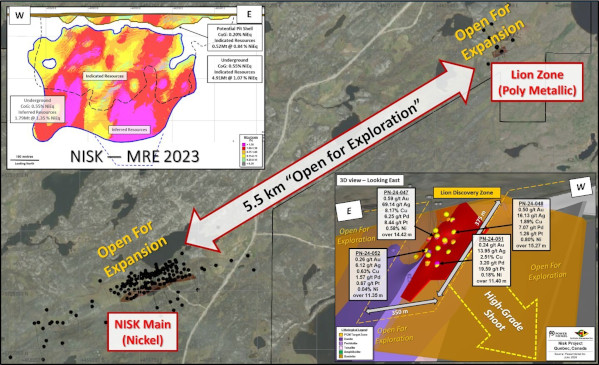The NISK project in Quebec, Canada, is a major discovery of high-grade battery metals, including nickel, copper, platinum group metals (PGMs), silver, and gold.
Located near the town of Nemaska, NISK is well-positioned beside a major highway, with easy access to low-carbon hydropower and shallow mineral depth with ultramafic tailings. NISK's strategic positioning and geology enable it to be a safe, reliable and carbon-neutral source of critical minerals.

The NISK deposit is Power Nickel's flagship project located near Nemaska, Quebec. It represents a significant discovery of high-grade battery metals, including nickel, copper, platinum group metals (PGMs), silver, and gold. Located in one of the safest jurisdictions in the world, the project benefits from an abundant supply of low-carbon hydropower, shallow mineral depth, and ultramafic tailings, enabling it to be carbon neutral with minimal environmental impact.
NISK contains potentially massive strike lengths with two distinct high-grade mineralized zones separated by 5.5 kilometers. The theory is that these areas are connected beneath the surface, creating a potentially vast mineralized area. The NISK Main zone features high-grade class-1 nickel with intercepts of 18.5 meters at 2.00% NiEQ and 26.6 meters at 1.98% NiEQ. The Lion Discovery showcases zones with copper up to 8%, PGMs over 22 grams per ton, gold over 1.6 grams per ton, and silver over 69 grams per ton.
The project is carbon-neutral, utilizing ultramafic tailings for carbon capture that will sequester more carbon than emitted during operation. Access to inexpensive hydropower from a nearby Hydro-Québec substation and generous tax incentives, combined with a shallow mineral depth, keep operational costs low. Quebec and the Canadian government offer substantial tax credits covering 50% of exploration costs, effectively doubling the exploration budget. The site boasts robust infrastructure, with proximity to a major highway, the Hydro-Québec substation, and a nearby town with an airport, enhancing logistical efficiency.

Explore the NISK project